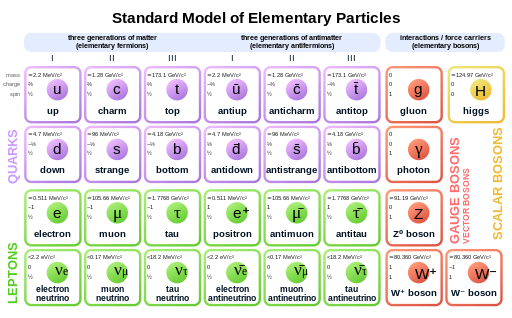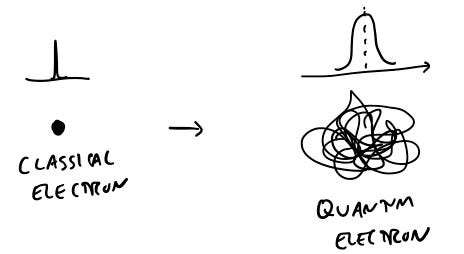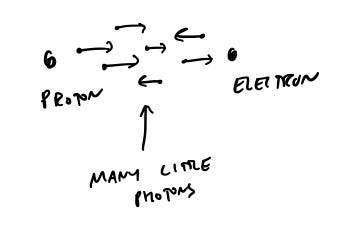A (Gentle) Introduction to String Theory: Particles and Gravity
What is string theory and what does it have to do with the rest of physics? Part 1 of a 2-part post, with some background on particle physics and gravity.
I want to give you the gentlest possible introduction to string theory.
Depending on who you read, you might have heard string theory described as “a theory of everything”, “a piece of 21st-century physics that had fallen by accident into the 20th century” or — rather differently — “a colossal failure” that is “not even wrong”.
It may seem perplexing that an idea in theoretical physics can generate such a varied and emotionally intense response. So I’m going to explain what string theory is and what it tries to do. I’m not going to assume that you really have any physics knowledge, just some enthusiasm about the universe.
Before getting to string theory itself, I’ll need to explain some things about particles and gravity. So in this post I’ll give you some background on the problem of quantum gravity, which is the problem that string theory is trying to solve. String theory itself will make its dramatic appearance in the next post. (This post is based on various public lectures I’ve given — if you like videos better, you can watch a talk with basically the same exposition here.)
What is everything made of?
Early on in our education we learn that things — you, me, your computer screen, the mug of coffee that sits in front of me — are made out of particles. You and I are mostly made of water, which is made out of water molecules. Each water molecule is made out of three atoms — two hydrogen, and one oxygen. Each hydrogen atom is itself made out of a proton with an electron spinning around it. Each of the protons is made of three smaller (and I suppose slightly lesser-known) particles called quarks. The field of study devoted to these smallest of particles is (unsurprisingly) called particle physics.
This is more or less where humanity’s (experimental) knowledge of particle physics stops, but from this brief description you might already be wondering whether this simply keeps going: are quarks made of smaller sub-particles? And how about those sub-particles? Do the turtles really go all the way down? We will revisit this question eventually.
Now, another question: what else is there besides particles? The other concept that gives structure to the universe is forces; a force is the name that we give to the mechanism by which particles interact with one another.
For example, if you take a proton and place it next to an electron, the electron will (first slowly, then quickly) be pulled towards the proton. The thing that causes this to happen is called the electromagnetic force. It is this force that holds the hydrogen atom together and keeps the electron in orbit around the proton. It is also this force that causes things like lightning, magnetism, the existence of solid matter, and the propagation of visible light (by which you are presumably reading these words). In fact, most phenomena on ordinary human scales involves electromagnetism in some manner or another.
What are the other forces? It turns out there are three others. One of them is the strong nuclear force, which holds the three quarks in the proton together. Another is the weak nuclear force, which I won’t talk any more about because it is less intuitive (and, well — weak).
There is clearly one more force — really the most obvious of all — which we’ll get to in a second.
Quantum mechanics means that forces are carried by particles
The next thing we have to understand is that at the smallest scales, nature does not really behave the way we expect it to from our experience with everyday normal-size objects. To continue with my coffee mug as an example of a normal-size object: it has a well-defined position. It sits there. It is a meaningful statement to say that my coffee mug sits in front of me, and does not sit, for example, on the street outside.
As it turns out, nature on small scales doesn’t behave in this common-sense manner; a small object like an electron does not typically have a well-defined position. Instead, it obeys the rules of quantum mechanics, which I’m going to try and summarize in the following brutally oversimplified way:
Quantum mechanics says that an object always does multiple things at once.
This statement isn’t meant to be mystical or confusing, but sadly it can seem that way if you are encountering it for the first time. Let’s continue with the electron as an example: an electron operates according to the rules of quantum mechanics, which means that it does many things at once. By this I mean that it does not have a definite position — instead it is usually in many different places at once, with a certain probability of being in any one particular place. You can imagine the point-like electron of ordinary physics broadening into a kind of misty electron cloud — wherever the tendrils of the cloud1 extend, there is a chance that I may find my wandering quantum electron there.
That is what happens to particles in a quantum mechanical world. Now recall from above that our universe has both particles and forces; what happens to the forces in a quantum mechanical world?
If you push through the implications, quantum mechanics turns out to imply not only that matter is made of particles, but also that forces are carried by many little particles. For example, the electromagnetic force that I mentioned earlier — the proton tugging on the electron — turns out to be carried by many tiny particles called photons. You can imagine the electron and proton each spitting out and absorbing many many of these photon particles each instant, and the cumulative effect of all of these particles flying back and forth is to make the proton and electron attract each other. The quarks inside the proton do basically the same thing — they each emit many particles that are somewhat endearingly called gluons, because they end up gluing the quarks together to make up a proton. (The area of physics devoted to this is called quantum field theory).
Now that forces are also made up of particles, it seems that we have something of an economy of description. We can just make a list of all of these different kinds of particles — matter particles like electrons and quarks, and force particles like photons and gluons — and describe how the different kinds of particles interact with each other. This has been done for almost all of the forces, and is one of the great achievements of twentieth century physics. It’s called the Standard Model of Particle Physics.

It is a phenomenally successful theory. It is a theory of almost everything. The dizzying variety of matter that you see around you — you, me, the coffee cup, clouds, the oceans, etc. etc. — is basically all made up of the particles in that table, arranged in the correct proportions. It’s brilliant.
But there is one glaring omission.
The Problem of Gravity
You have probably already noticed that I have carefully avoided mentioning gravity above. This may seem peculiar — on ordinary human scales, gravity is actually the most obvious force, and it is usually the very first force we learn about in school — so why am I awkwardly avoiding it?
I am avoiding it because it does not quite fit into the framework I’ve just given you.
The basic reason why is that gravity feels too much.
In your soul you actually already know this. If you have ever wearily trudged up a too-long flight of steps, then you are completely aware that there is no way to escape from the pull of gravity. In this way gravity is actually different from the other forces, such as electromagnetism. If you want to escape from external electromagnetic fields there are various ways to do it: for example you could consider an object made out of an equal number positive and negative charges — like a hydrogen atom — which is electrically neutral. There is just no way to do this for gravity — you simply can’t assemble together any pieces of matter to make an object that does not feel gravity. More formally, you might recall that the strength of the gravitational force depends on the mass of the object it’s pulling on. It’s a common-sense fact that everything has mass, and there’s no way to make an object with “anti-mass” to cancel out the mass of something else.
Now, let’s combine this with the quantum mechanics ideas above. What does this imply for the putative particle that would be associated with the gravitational force? We would call such a particle a graviton, and the rules of quantum mechanics would say that (for example) both I and the earth are continuously spitting out and absorbing a stream of these gravity particles. This steady stream of gravitons eventually results in a constant force downwards on my body, keeping me in my chair, and preventing me from floating off into space.
So far, there is no problem. But now let’s zoom in on this picture. Look carefully at some of these gravitons. They are little particles flying back and forth, and this means that they carry energy. But from Einstein’s famous equation, we know that mass and energy are basically the same thing2, and thus the gravity particles will themselves will feel the gravitational force. But this means that the gravity particles are themselves emitting gravity particles. And if we zoom in on those new gravity particles then we see that at smaller scales they have more and more energy, and they too will be emitting more and more gravity particles. And so on and so forth — in fact, as you zoom in further and further the problem gets more and more serious, until at small scales we conclude in despair that there are simply too many gravity particles flying everywhere and we really don’t know how to make sense of it.
This is the fundamental problem of quantum gravity: there are just too many gravity particles at short distances. This property has a technical name: the theory of quantum gravity is said to be non-renormalizable, which just means that we don’t know how to make sense of it at small scales.
On the other hand, at longer scales — the scales at which we normally imagine gravity to operate, the scale of planets and galaxies and galaxy-clusters — there is really no issue at all. The thorniness of quantum gravity and the unbearable proliferation of gravitons really becomes a problem only when you look at things that are very, very small. You can figure out how small by wrapping some equations around the words that I put above: if you do so, then you conclude the quantum gravity becomes an observable problem at roughly the Planck length, 10^(-35) metres or so. This is so insanely small that I really struggle to think of a helpful analogy to explain it.
It is definitely not directly testable in any sort of experiment that I can imagine. Experimentally we probe small things with particle accelerators, which you can imagine as very powerful microscopes, in that they let us — rather indirectly — see what is happening at tiny distance scales. The most powerful particle accelerator — built at great expense and for many years — has currently probed distances of about 10^(-17) metres. There is (I think) no hope for bridging the remaining 18 orders of magnitude in any reasonable way.
Do I care?
At this point, it’s good to take a step back and ask yourself: “If quantum gravity is only an issue at extremely small distances — that we will probably never probe with a direct experiment — do I really care?”
This is a reasonable question. I won’t really judge you3 if you decide that you only want to understand things that can be directly measured in an experiment. If that’s the case, quantum gravity probably isn’t for you. (Luckily, there are other sources of joy and happiness in the universe).
But maybe you’re worried that two of the fundamental principles that govern the universe — the fact that particles mediate forces, and the obvious fact that gravity exists — seem to be incompatible with each other at small distances. Maybe you will now lie awake at night worried about all the gravitons milling about. This is of course a strictly theoretical worry, but maybe you are nevertheless concerned at this basic tension and are now wondering if there’s a way to make sense of it all.
It turns out that there is. In the next post I’ll discuss string theory, which happily solves this problem.
This cloud is called the wavefunction, and in your first quantum mechanics course you learn how to calculate the strength of the cloud at each point by solving Schrodinger’s equation.
I am being imprecise here. The truth is that E = mc^2 doesn’t apply to the graviton directly. But there’s a different equation that does. And the conclusion — that the energy of the graviton determines the strength of its interaction with gravity, and more energy means a stronger effect of gravity, is true.
Actually I’ll probably judge you a little bit.






